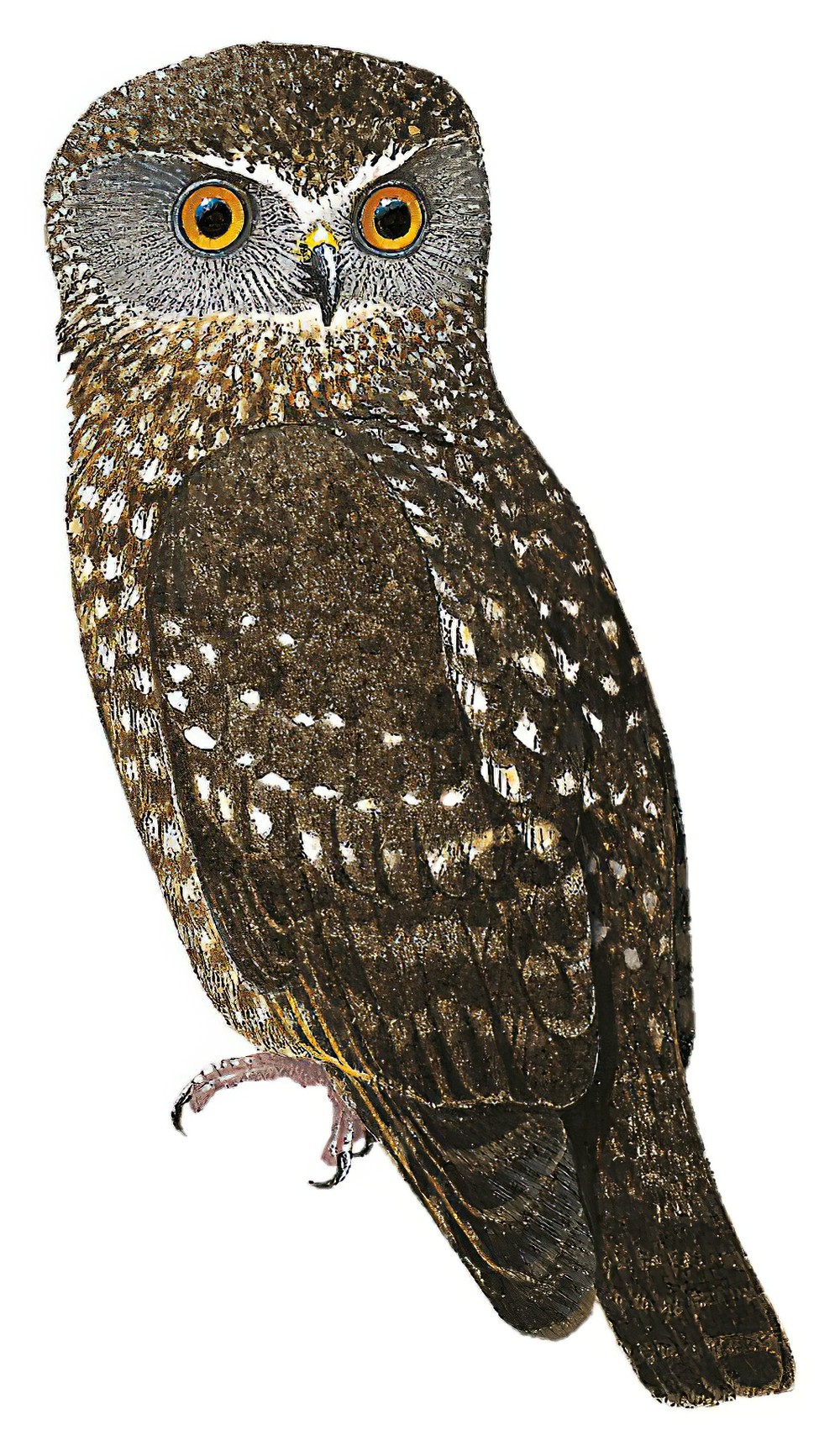Morepork / Ninox novaeseelandiae

Morepork
SCI Name:
Protonym: Strix novae Seelandiae Syst.Nat. 1 pt1 p.296
Taxonomy: Strigiformes / Strigidae / Ninox
Taxonomy Code: morepo2
Type Locality: New Zealand = Queen Charlotte Sound, South Island, ex Latham, Gen. Syn., 1, pt. 1, p. 149, no. 39.
Author: Gmelin, JF
Publish Year: 1788
IUCN Status:
DEFINITIONS
NINOX
(Strigidae; Ϯ Brown Hawk Owl N. scutulata lugubris) Portmanteau of genera Nisus Cuvier, 1800, hawk, and Noctua de Savigny, 1809, owl; “Genus NINOX, nobis (a Niso et Noctua). Type NINOX Nipalensis, nobis. Character.—Bill, disc, conch, and feet as in Noctua.—General contour, with the character of the plumage, strictly falconidine. Wings long and firm, 3d quill longest, 1st and 2d moderately gradated; the primes, pretty strongly emarginated high up from the tips; their edges, entirely or nearly so. Tail long, straight and even. Type, Ninox Nipalensis, nobis. Habitat, central region of Nepal. Habits, insectivorous and crepuscular. The experienced Shikaree who brought me, recently, a fine male specimen of this bird, asked me, when he put it in my hand, whether it was a Baaz (hawk) or an Ulu (owl)? And the more I examined its graceful form, its unrelaxed plumage, its strong and ample wings and tail, and even its peculiar colouring, the greater reason did I perceive to admire the man’s acuteness of observation. It is an owl, undoubtedly, but the most accipitrine of owls; and, much as the peculiar attributes of Noctua had prepared me to expect, in or near this group of the Strigidæ, the type and symbol of the Accipitrinæ, I did not hope that the forests of Nepal would so soon yield that type to my own hands.* SPECIES new, Nipalensis nobis. ... *I regret I have no species of Surnia wherewith to compare our bird. Surnia may possibly dispute with it the honour of typifying the nobler races of the Falconidæ: but the thickly plumed toes and wedged tail of Surnia, sufficiently indicate that our bird is not of that genus.” (Hodgson 1837); "Ninox Hodgson, Madras Journ. Lit. Sci., 5, 1837, p. 23. Type, by monotypy, Ninox nipalensis Hodgson = Strix lugubris Tickell." (Peters 1940, IV, 136).
Synon. Berneyornis, Cephaloglaux, Cephaloptynx, Ctenoglaux, Hieracoglaux, Rhabdoglaux, Rhodoglaux, Spiloglaux.
novaeseelandiae
L. novus new; Mod. L. Zeelandia or Seelandia Zeeland, Netherlands; i.e. New Zealand (also New Zeeland and New Zeland, which received its name from the explorer Abel Tasman who explored the west coast in 1642, naming it Nova Zeelanda after his Dutch home).
● ex “New-Zealand Lark” of Latham 1783 (Anthus).
● ex “New-Zealand Duck” of Latham 1785 (Aythya).
● Erroneous TL New Zealand (= Tahiti); ex “Red-rumped Parrot” of Latham 1781 (syn. Cyanoramphus zealandicus).
● ex “New-Zealand Falcon” of Latham 1781 (Falco).
● ex “New-Zealand Titmouse” of Latham 1783 (Finschia).
● ex “New Zealand Pigeon” of Latham 1783 (Hemiphaga).
● ex “New-Zeeland Owl” of Latham 1781 (Ninox).
● ex “New Zealand Creeper” of Brown 1776, and “Poë Bee-eater” of Latham 1782 (Prosthemadera).
SUBSPECIES
Morepork (Tasmanian)
SCI Name: Ninox novaeseelandiae leucopsis
leucopsis
Gr. λευκος leukos white; οψις opsis face.
● ex “Canard du Maragnon” of d’Aubenton 1765-1781, pl. 808 (syn. Dendrocygna viduata).
Morepork (novaeseelandiae Group)
SCI Name: Ninox novaeseelandiae [novaeseelandiae Group]
NINOX
(Strigidae; Ϯ Brown Hawk Owl N. scutulata lugubris) Portmanteau of genera Nisus Cuvier, 1800, hawk, and Noctua de Savigny, 1809, owl; “Genus NINOX, nobis (a Niso et Noctua). Type NINOX Nipalensis, nobis. Character.—Bill, disc, conch, and feet as in Noctua.—General contour, with the character of the plumage, strictly falconidine. Wings long and firm, 3d quill longest, 1st and 2d moderately gradated; the primes, pretty strongly emarginated high up from the tips; their edges, entirely or nearly so. Tail long, straight and even. Type, Ninox Nipalensis, nobis. Habitat, central region of Nepal. Habits, insectivorous and crepuscular. The experienced Shikaree who brought me, recently, a fine male specimen of this bird, asked me, when he put it in my hand, whether it was a Baaz (hawk) or an Ulu (owl)? And the more I examined its graceful form, its unrelaxed plumage, its strong and ample wings and tail, and even its peculiar colouring, the greater reason did I perceive to admire the man’s acuteness of observation. It is an owl, undoubtedly, but the most accipitrine of owls; and, much as the peculiar attributes of Noctua had prepared me to expect, in or near this group of the Strigidæ, the type and symbol of the Accipitrinæ, I did not hope that the forests of Nepal would so soon yield that type to my own hands.* SPECIES new, Nipalensis nobis. ... *I regret I have no species of Surnia wherewith to compare our bird. Surnia may possibly dispute with it the honour of typifying the nobler races of the Falconidæ: but the thickly plumed toes and wedged tail of Surnia, sufficiently indicate that our bird is not of that genus.” (Hodgson 1837); "Ninox Hodgson, Madras Journ. Lit. Sci., 5, 1837, p. 23. Type, by monotypy, Ninox nipalensis Hodgson = Strix lugubris Tickell." (Peters 1940, IV, 136).
Synon. Berneyornis, Cephaloglaux, Cephaloptynx, Ctenoglaux, Hieracoglaux, Rhabdoglaux, Rhodoglaux, Spiloglaux.
UPPERCASE: current genus
Uppercase first letter: generic synonym
● and ● See: generic homonyms
lowercase: species and subspecies
●: early names, variants, mispellings
‡: extinct
†: type species
Gr.: ancient Greek
L.: Latin
<: derived from
syn: synonym of
/: separates historical and modern geographic names
ex: based on
TL: type locality
OD: original diagnosis (genus) or original description (species)












